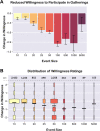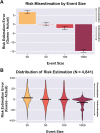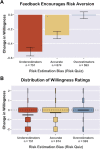Communicating COVID-19 exposure risk with an interactive website counteracts risk misestimation
- PMID: 37796971
- PMCID: PMC10553796
- DOI: 10.1371/journal.pone.0290708
Communicating COVID-19 exposure risk with an interactive website counteracts risk misestimation
Abstract
During the COVID-19 pandemic, individuals depended on risk information to make decisions about everyday behaviors and public policy. Here, we assessed whether an interactive website influenced individuals' risk tolerance to support public health goals. We collected data from 11,169 unique users who engaged with the online COVID-19 Event Risk Tool (https://covid19risk.biosci.gatech.edu/) between 9/22/21 and 1/22/22. The website featured interactive elements, including a dynamic risk map, survey questions, and a risk quiz with accuracy feedback. After learning about the risk of COVID-19 exposure, participants reported being less willing to participate in events that could spread COVID-19, especially for high-risk large events. We also uncovered a bias in risk estimation: Participants tended to overestimate the risk of small events but underestimate the risk of large events. Importantly, even participants who voluntarily sought information about COVID risks tended to misestimate exposure risk, demonstrating the need for intervention. Participants from liberal-leaning counties were more likely to use the website tools and more responsive to feedback about risk misestimation, indicating that political partisanship influences how individuals seek and engage with COVID-19 information. Lastly, we explored temporal dynamics and found that user engagement and risk estimation fluctuated over the course of the Omicron variant outbreak. Overall, we report an effective large-scale method for communicating viral exposure risk; our findings are relevant to broader research on risk communication, epidemiological modeling, and risky decision-making.
Copyright: © 2023 Sinclair et al. This is an open access article distributed under the terms of the Creative Commons Attribution License, which permits unrestricted use, distribution, and reproduction in any medium, provided the original author and source are credited.
Conflict of interest statement
The authors have declared that no competing interests exist.
Figures






References
-
- World Health Organization. Coronavirus. In: Coronavirus Disease (COVID-19) [Internet]. [cited 22 Aug 2022]. Available: https://www.who.int/health-topics/coronavirus
-
- World Health Organization. Monkeypox. In: WHO Fact Sheet on Monkeypox [Internet]. [cited 22 Aug 2022]. Available: https://www.who.int/news-room/fact-sheets/detail/monkeypox
-
- World Health Organization. Influenza (seasonal). In: lnfluenza (seasonal) [Internet]. [cited 22 Aug 2022]. Available: https://www.who.int/health-topics/influenza-seasonal
Publication types
MeSH terms
Supplementary concepts
LinkOut - more resources
Full Text Sources
Medical

